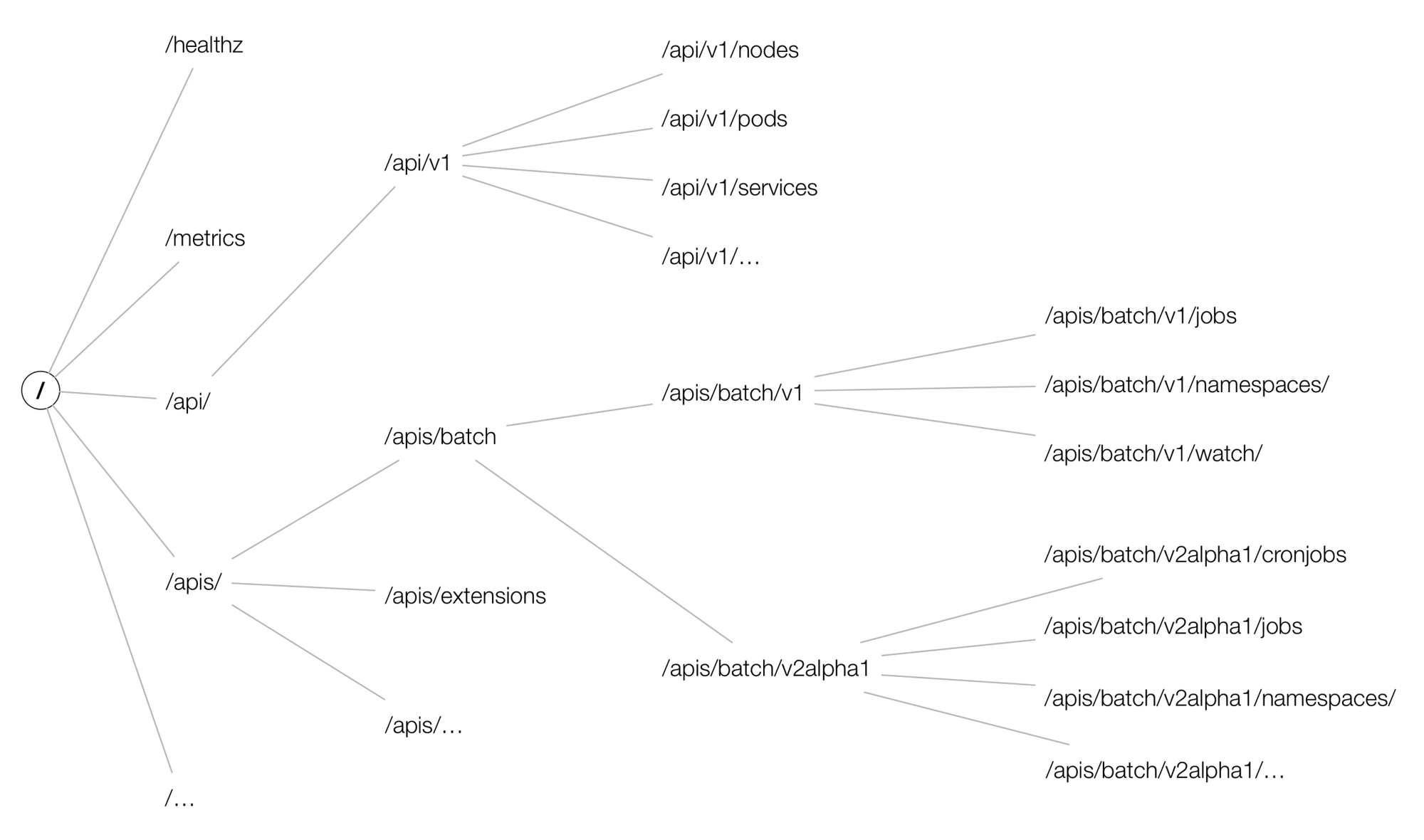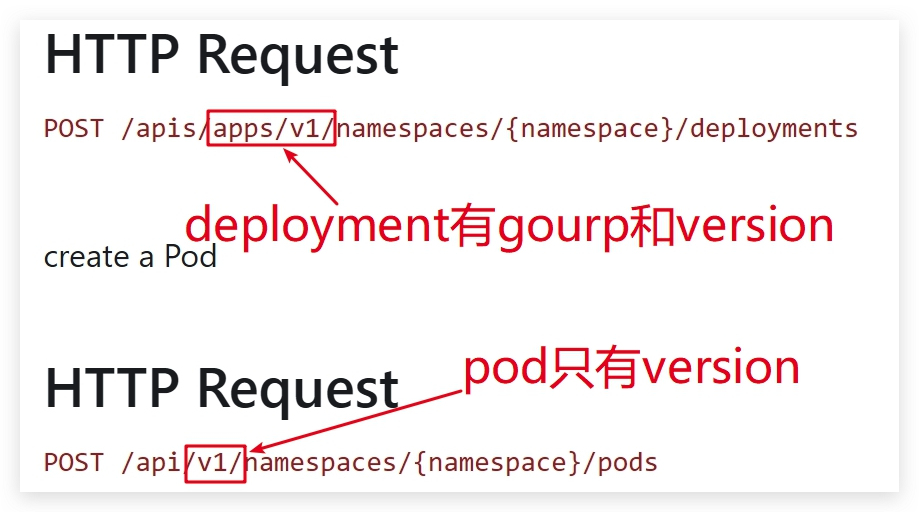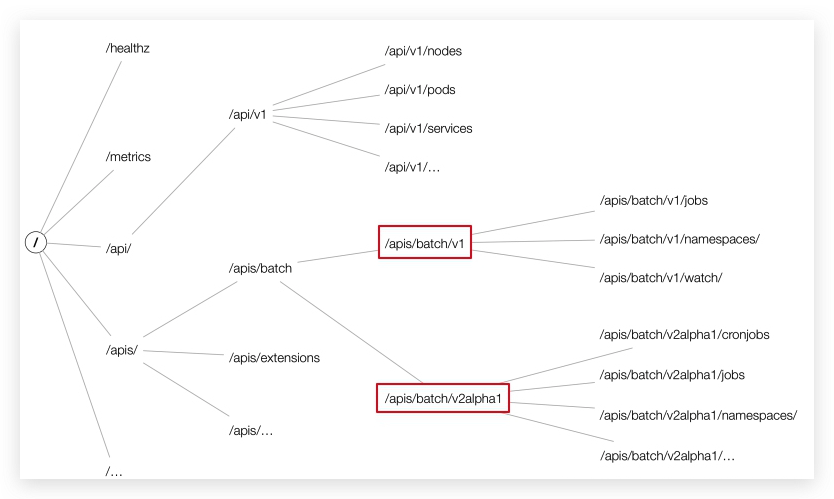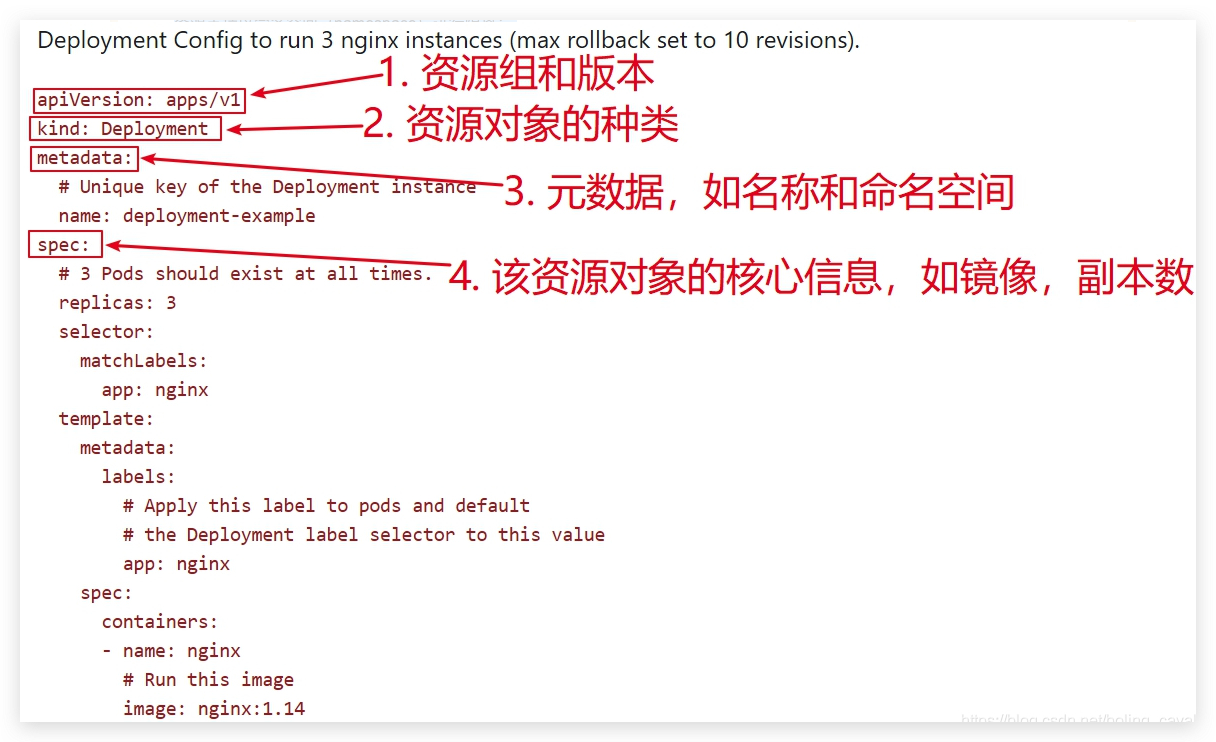01-K8s 开发相关概念
一 运行环境
1.1 IDE
- IDE:goland
- go版本:go1.16.8
- kubernetes:v1.21.1
1.2 K8s 相关仓库
官方源码仓库: https://github.com/kubernetes/kubernetes.git
1.3 K8s 源码目录结构
$ git clone https://github.com/kubernetes/kubernetes.git
1.4 需要掌握的知识点
- golang基础
- k8s相关知识
- cobra
- client-go
- controller相关组件及流程
- operator开发框架kubebuilder
- gin框架
二 kubernetes API 认识
Kubernetes 中最核心的就是 kube-apiserver 组件,其他组件都是和 kube-apiserver 进行通信的,本节主要就来研究下 Kubernetes API 接口的模型。
2.1 API 对象
在 Kubernetes 集群中,Kubernetes 对象是我们持久化的实体,就是最终存入 etcd 中的数据,集群中通过这些实体来表示整个集群的状态。平时我们都是直接编写 YAML 资源清单文件,然后通过 kubectl 来提交创建对应的资源对象,映射到集群内部。
这个就需要去了解下**声明式 API**的设计,为了可扩展性,Kubernetes 在不同的 API 路径(比如/api/v1 或者 /apis/batch)下面支持了多个 API 版本,不同的 API 版本意味着不同级别的稳定性和支持:
- Alpha 级别,例如
v1alpha1默认情况下是被禁用的,可以随时删除对功能的支持,所以要慎用 - Beta 级别,例如
v2beta1默认情况下是启用的,表示代码已经经过了很好的测试,但是对象的语义可能会在随后的版本中以不兼容的方式更改 - 稳定级别,比如
v1表示已经是稳定版本了,也会出现在后续的很多版本中。
2.2 API PATH
在 Kubernetes 集群中,一个 API 对象在 Etcd 里的完整资源路径,是由:Group(API 组)、Version(API 版本)和 Resource(API 资源类型)三个部分组成的。通过这样的结构,整个 Kubernetes 里的所有 API 对象,实际上就可以用如下的树形结构表示出来:

2.3 GVK
2.3.1 概念
GVK = GroupVersionKind,GVR = GroupVersionResource。
- apiVersion:这个就是 GV 。
- kind:这个就是 K。根据 GVK K8s 就能找到你到底要创建什么类型的资源,根据你定义的 Spec 创建好资源之后就成为了 Resource,也就是 GVR。GVK/GVR 就是 K8s 资源的坐标,是我们创建/删除/修改/读取资源的基础。
2.3.2 关系图

2.3.2.1 Group
Group即资源组,在kubernetes对资源进行分组时,对应的数据结构就是Group,源码路径:k8s.io/apimachinery/pkg/apis/meta/v1/types.go ,如下,可见Group有自己的名称和版本:
type APIGroup struct {
TypeMeta `json:",inline"`
Name string `json:"name" protobuf:"bytes,1,opt,name=name"`
Versions []GroupVersionForDiscovery `json:"versions" protobuf:"bytes,2,rep,name=versions"`
PreferredVersion GroupVersionForDiscovery `json:"preferredVersion,omitempty" protobuf:"bytes,3,opt,name=preferredVersion"`
ServerAddressByClientCIDRs []ServerAddressByClientCIDR `json:"serverAddressByClientCIDRs,omitempty" protobuf:"bytes,4,rep,name=serverAddressByClientCIDRs"`
}
在kubernetes中有两种资源组:
- 有组名资源组,例如deployment
- 无组名资源组(也叫核心资源组Core Groups),它们都很常见,例如单个pod
deployment有组名,pod没有组名,咱们把它俩的OpenAPI放在一起对比就一目了然了

2.3.2.2 Version
- Version即版本,这个好理解,kubernetes的版本分为三种:
- Alpha:内部测试版本,如v1alpha1
- Beta:经历了官方和社区测试的相对稳定版,如v1beta1
- Stable:正式发布版,如v1、v2
如下图红框,资源组batch之下有v1和v2alpha1两个版本,每个版本下都有多个资源:

数据结构源码还是在types.go文件中
type APIVersions struct {
TypeMeta `json:",inline"`
Versions []string `json:"versions" protobuf:"bytes,1,rep,name=versions"`
ServerAddressByClientCIDRs []ServerAddressByClientCIDR `json:"serverAddressByClientCIDRs" protobuf:"bytes,2,rep,name=serverAddressByClientCIDRs"`
}
2.3.2.3 Resource
- Resource资源在kubernetes中的重要性是不言而喻的,常见的pod、service、deployment这些都是资源,下面是关于资源的一些小结:
- 在kubernetes环境被实例化的资源即资源对象(ResourceObject);
- 资源被分为持久性(Persistent Entity)和非持久性(Ephemeral Entity),持久性如deployment,创建后会在etcd保存,非持久性如pod;
type APIResource struct {
Name string `json:"name" protobuf:"bytes,1,opt,name=name"`
SingularName string `json:"singularName" protobuf:"bytes,6,opt,name=singularName"`
Namespaced bool `json:"namespaced" protobuf:"varint,2,opt,name=namespaced"`
Group string `json:"group,omitempty" protobuf:"bytes,8,opt,name=group"`
Version string `json:"version,omitempty" protobuf:"bytes,9,opt,name=version"`
Kind string `json:"kind" protobuf:"bytes,3,opt,name=kind"`
Verbs Verbs `json:"verbs" protobuf:"bytes,4,opt,name=verbs"`
ShortNames []string `json:"shortNames,omitempty" protobuf:"bytes,5,rep,name=shortNames"`
Categories []string `json:"categories,omitempty" protobuf:"bytes,7,rep,name=categories"`
StorageVersionHash string `json:"storageVersionHash,omitempty" protobuf:"bytes,10,opt,name=storageVersionHash"`
}
kubernetes为资源准备了8种操作:create、delete、deletecollection、get、list、patch、update、watch,每一种资源都支持其中的一部分,这在每个资源的API文档中可以看到;
资源支持以命名空间(namespace)进行隔离;
资源对象描述文件在日常操作中频繁用到,一共由五部分组成:apiVersion、kind、metadata、spec、status,下图是官方的deployment描述文件,用于创建3个nginx pod,对着红框和文字就了解每个部分的作用了:

- 上图并没有status,该部分是用来反应当前资源对象状态的,体现在资源的数据结构中,如下所示:
type Deployment struct {
metav1.TypeMeta `json:",inline"`
metav1.ObjectMeta `json:"metadata,omitempty" protobuf:"bytes,1,opt,name=metadata"`
Spec DeploymentSpec `json:"spec,omitempty" protobuf:"bytes,2,opt,name=spec"`
Status DeploymentStatus `json:"status,omitempty" protobuf:"bytes,3,opt,name=status"`
}
2.4 APIResources数据结构
- APIResource是个常用的数据结构了,可以用来描述资源,例如resource_quota_controller_test.go中有对其的使用:
func TestDiscoverySync(t *testing.T) {
serverResources := []*metav1.APIResourceList{
{
GroupVersion: "v1",
APIResources: []metav1.APIResource{
{Name: "pods", Namespaced: true, Kind: "Pod", Verbs: metav1.Verbs{"create", "delete", "list", "watch"}},
},
},
}
unsyncableServerResources := []*metav1.APIResourceList{
{
GroupVersion: "v1",
APIResources: []metav1.APIResource{
{Name: "pods", Namespaced: true, Kind: "Pod", Verbs: metav1.Verbs{"create", "delete", "list", "watch"}},
{Name: "secrets", Namespaced: true, Kind: "Secret", Verbs: metav1.Verbs{"create", "delete", "list", "watch"}},
},
},
}
2.5 实际操作
- 聊了这么久理论,接下来咱们在kubernetes环境执行一些和资源有关的操作;
- 查看所有资源kubectl api-resources -o wide,可见当前环境的所有资源,及其相关属性:
[root@kubebuilder 07]# kubectl api-resources -o wide
NAME SHORTNAMES APIVERSION NAMESPACED KIND VERBS
bindings v1 true Binding [create]
componentstatuses cs v1 false ComponentStatus [get list]
configmaps cm v1 true ConfigMap [create delete deletecollection get list patch update watch]
endpoints ep v1 true Endpoints [create delete deletecollection get list patch update watch]
events ev v1 true Event [create delete deletecollection get list patch update watch]
limitranges limits v1 true LimitRange [create delete deletecollection get list patch update watch]
namespaces ns v1 false Namespace [create delete get list patch update watch]
...
- 只看apps这个group下面的资源kubectl api-resources --api-group apps -o wide:
[root@kubebuilder 07]# kubectl api-resources --api-group apps -o wide
NAME SHORTNAMES APIVERSION NAMESPACED KIND VERBS
controllerrevisions apps/v1 true ControllerRevision [create delete deletecollection get list patch update watch]
daemonsets ds apps/v1 true DaemonSet [create delete deletecollection get list patch update watch]
deployments deploy apps/v1 true Deployment [create delete deletecollection get list patch update watch]
replicasets rs apps/v1 true ReplicaSet [create delete deletecollection get list patch update watch]
statefulsets sts apps/v1 true StatefulSet [create delete deletecollection get list patch update watch]
- 查看指定资源的详情kubectl explain configmap:
[root@kubebuilder 07]# kubectl explain configmap
KIND: ConfigMap
VERSION: v1
DESCRIPTION:
ConfigMap holds configuration data for pods to consume.
FIELDS:
apiVersion <string>
APIVersion defines the versioned schema of this representation of an
object. Servers should convert recognized schemas to the latest internal
value, and may reject unrecognized values. More info:
https://git.k8s.io/community/contributors/devel/sig-architecture/api-conventions.md#resources
binaryData <map[string]string>
...
- 查看所有Group和Version的命令kubectl api-versions
[root@kubebuilder 07]# kubectl api-versions
admissionregistration.k8s.io/v1
admissionregistration.k8s.io/v1beta1
apiextensions.k8s.io/v1
apiextensions.k8s.io/v1beta1
apiregistration.k8s.io/v1
apiregistration.k8s.io/v1beta1
apps/v1
authentication.k8s.io/v1
authentication.k8s.io/v1beta1
authorization.k8s.io/v1
authorization.k8s.io/v1beta1
autoscaling/v1
autoscaling/v2beta1
autoscaling/v2beta2
batch/v1
batch/v1beta1
certificates.k8s.io/v1
certificates.k8s.io/v1beta1
coordination.k8s.io/v1
coordination.k8s.io/v1beta1
discovery.k8s.io/v1beta1
events.k8s.io/v1
events.k8s.io/v1beta1
extensions/v1beta1
flowcontrol.apiserver.k8s.io/v1beta1
networking.k8s.io/v1
networking.k8s.io/v1beta1
node.k8s.io/v1
node.k8s.io/v1beta1
policy/v1beta1
rbac.authorization.k8s.io/v1
rbac.authorization.k8s.io/v1beta1
scheduling.k8s.io/v1
scheduling.k8s.io/v1beta1
storage.k8s.io/v1
storage.k8s.io/v1beta1
v1
webapp.com.bolingcavalry/v1
- 点赞
- 收藏
- 关注作者


评论(0)